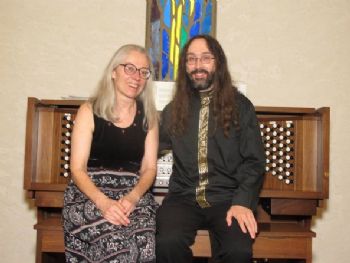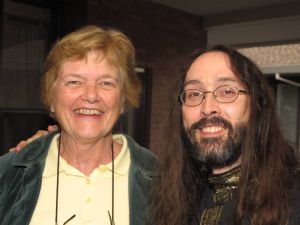|
Symphony
MONUMENTAL MAHLER 5TH IN SO CO PHIL'S SEASON ENDING CONCERT
by Terry McNeill
Sunday, April 14, 2024
Chamber
OAKMONT SEASON CLOSES WITH STRAUSS' PASSIONATE SONATA
by Terry McNeill
Thursday, April 11, 2024
Chamber
MORE GOLD THAN KORN AT ALEXANDER SQ CONCERT
by Terry McNeill
Sunday, April 7, 2024
Choral and Vocal
VIBRANT GOOD FRIDAY REQUIEM AT CHURCH OF THE ROSES
by Pamela Hicks Gailey
Friday, March 29, 2024
TWO OLD, TWO NEW AT THE SR SYMPHONY'S MARCH CONCERT IN WEILL
by Peter Lert
Saturday, March 23, 2024
Chamber
NOT A SEVENTH BUT A FIRST AT SPRING LAKE VILLAGE CONCERT
by Terry McNeill
Wednesday, March 20, 2024
THIRTY-THREE PLUS VARIATIONS AND AN OCEAN VIEW
by Terry McNeill
Saturday, March 16, 2024
Choral and Vocal
A ST. JOHN PASSION FOR THE AGES
by Abby Wasserman
Friday, March 8, 2024
Choral and Vocal
SPLENDID SCHUBERT SONGS IN SANET ALLEN RECITAL
by Terry McNeill
Saturday, March 2, 2024
Chamber
SHAW'S MICROFICTIONS HIGHLIGHTS MIRO QUARTET'S SEBASTOPOL CONCERT
by Peter Lert
Friday, March 1, 2024
|
 |
 Creative Arts Series' Beth Zucchino with Organist Leon W. Couch III (photo by Roy Crockett) |
COLORFUL VIRTUOSITY IN COUCH ORGAN RECITAL
by Jim Harrod
Sunday, November 1, 2009
Sonoma County hosted a magnificent exposition of the art of organ playing and interpretation on November 1 by Leon W. Couch III. Performing at the organ console of Resurrection Catholic Church in Santa Rosa and sponsored by the Creative Arts Series, Mr. Couch performed a selection of organ classics with remarkable virtuoso expertise.
The eclectic program included Buxtehude’s Praeludium in F-sharp Minor, (Bux WV 146, c 1690), Pachelbel’s Variations on Aria Sebaldina (Hexachordum Apollinis, 1699), Bach’s famous Toccata in F Major (BWV 540/1, 1707), Janet Linker’s Theme and Variations on “O Waly, Waly” (1999) and the Aria and Finale from Vierne’s Organ Symphony No. 6 in B, Op. 59 (1930).
Mr. Couch’s sensitive registration of organ stops for each of the selections was clearly the result of extensive scholarship in the selected music. The Buxtehude and the Pachelbel were performed with a large variety of flute and mutation stops typical of the north German Baroque instruments still existent today, and the Buxtehude was played with a restrained registration not often conceptualized by non-professional organists. The popular Bach Toccata was “candy-on-a-stick” with an electrically rapid pedal technique.
The only contemporary composition on the program, Janet Linker’s hymn variations “O Waly, Waly,” not only wAS beautiful but demonstrative of the organ’s flexibility in multiple musical genres. Selections from the Vierne symphony concluded the program with yet another display of outstanding pedal technique finger wizardry.
The Allen digital electronic instrument at Resurrection Parish and its excellent installation was well suited for this program. The organ has two sets of digitally sampled sounds of organ stops, one north European Baroque and one French, providing appropriate authentic voices for each of the pieces played. Mr. Couch’s program came to the audience complete with copious and scholarly program notes and spoken explanations and anecdotes by the artist before each selection. It was evident by this why he was named the Montague Teaching Excellence Scholar at Texas A & M in 2006. A most satisfying recital by a master colorist.
Redwood Empire AGO Chapter Dean Carolyn Wiester attend the recital:
This program was yet another of emotional magnitude for me, as the perfection of organ technique and interpretation by Mr. Couch was stunning. The beauty of thy stained glass windows in the church as the sun was receding was reflected in the pieces chosen by the organist, from melodic tones of minor keys in the Buxtehude and Pachelbel, to the glorious Bach Toccata.
After the European flavor of the first works, I was pleased by the contemporary American selection that included theater organ style, gospel, smaltzy jazz and sounds of Gershwin. And then finally to Paris, the seat of 19th-Century French organ music, with Vierne’s characteristic chromatic style. I could envision myself moving from the grandeur of Notre Dame’s huge cathedral to the more earthy show of spirited girls and Gallic fanfare. It was a magical organ experience.
|


